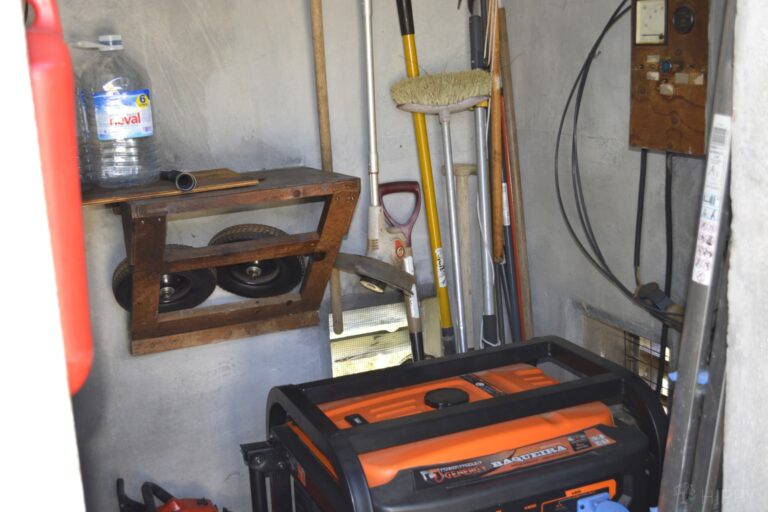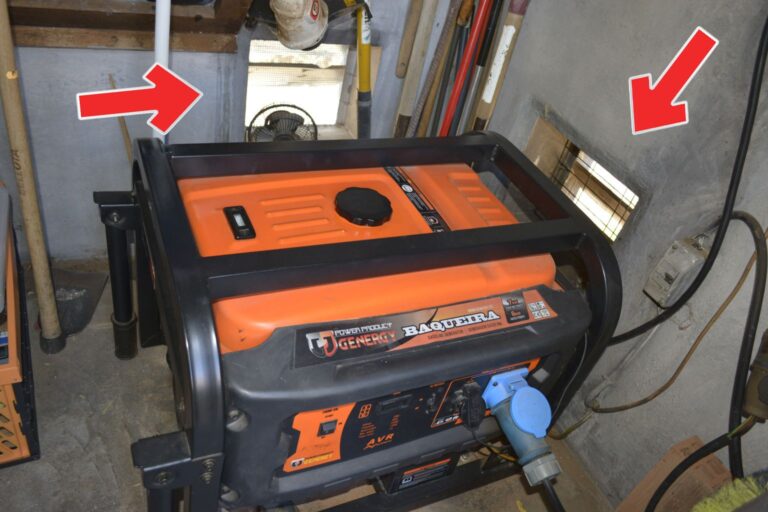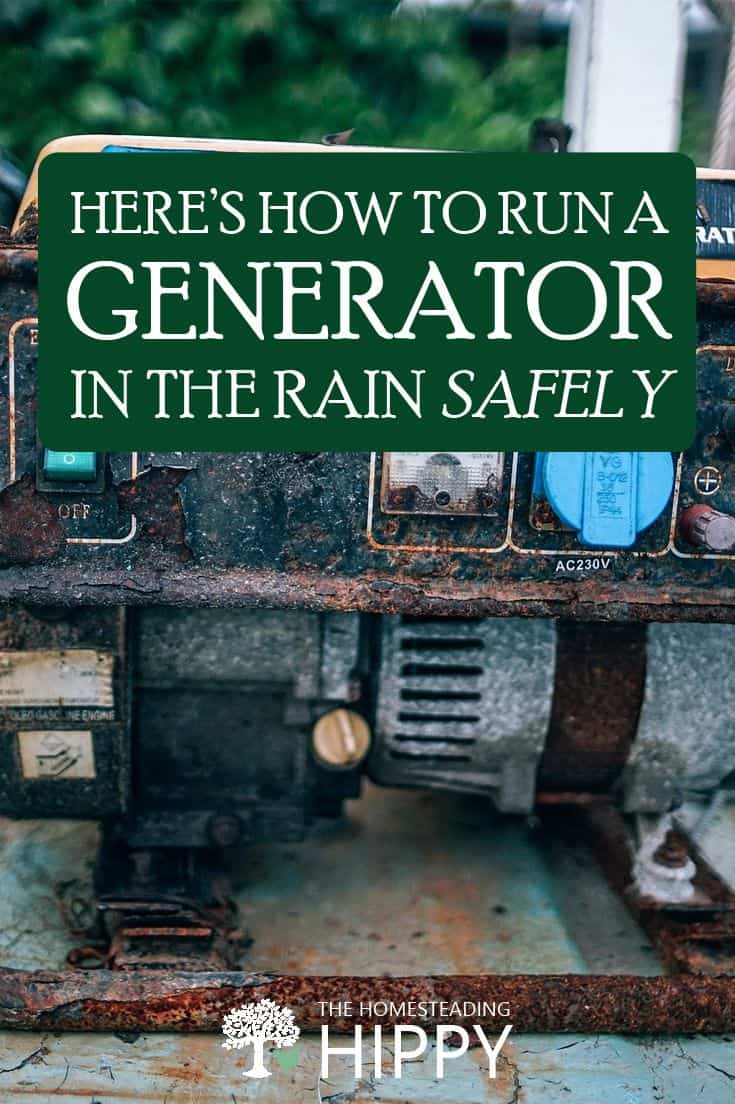Pretty much every homesteader understands the value of a generator.
Whether it is supplying power in a place where traditional service is unavailable, or keeping the lights on in the tools running after that same service has been knocked out, a generator is invaluable.

If your home and property get plunged into darkness because of bad weather, there’s hardly anything more comforting than knowing you can just go outside, fire up your heavy-duty generator and relax.
Unfortunately, this popular conception does not quite live up to the reality of just how vulnerable generators can be during wet conditions.
Generators that get wet while running can malfunction disastrously, perhaps being destroyed or posing a major electrocution hazard for you or other members of your family.
You never, ever want to run a generator directly in wet weather, and keeping it sheltered from precipitation, coming from above and below, is priority number one if you want to avoid trouble.
This article will tell you how, so you can run your generator safely in any weather conditions…
Table of Contents
Running a Generator in the Rain or Snow?
So, the bottom line is no, you should never run a generator in the open when raining or snowing – unless you take adequate protection measures.
Lacking a covering for your generator, which we will get to in a minute, can’t you just bring the generator inside your garage or maybe in a covered porch just off of your house? Wouldn’t that be okay?
No! You must never run your generator inside your house or near an opening to the inside of your house.
Any conventionally fueled generator- gasoline, propane or diesel- will produce exhaust gases containing carbon monoxide as a byproduct.
Carbon monoxide, or CO, gas is invisible, odorless, colorless, and tasteless – it is also deadly!
Carbon monoxide can easily build up in your home from an adjoining area, slowly poisoning everyone inside. you’ll start to feel sluggish, then a little sick, and then eventually experience flu-like symptoms before brain fog and a loss of coordination kick in.
After that, you’re only a hop and a skip away from unconsciousness, and death.
Dozens die every year from carbon monoxide poisoning due to running generators inside or too close to their homes, or else burning other combustible materials inside their home in an unsafe manner.
No matter how desperate the situation is you must never, ever run your generator inside your home or inside your garage where carbon monoxide gas could seep inside your home!
Can a Generator Get Wet and still Work?
We run our vehicles in the rain all the time, so it seems perfectly logical that we should be able to run a generator in the same conditions without causing any problems, right?
A generator is the same type of engine that can be found in any basic vehicle. It works by sucking air into a piston where it is mixed with fuel before being ignited. The ignition causes the piston to move and it is this movement that drives the car.
The spent gases are pushed out of the cylinder ready for the next cycle. Operating an engine in the rain runs the risk of several problems developing.
Comparing the operation of a generator to using a car in the rain with a little thought it should become obvious that the engine in a car is in an enclosure.
This enclosure, though protective against rain and snow, is not completely waterproof, and if flooded (say, by driving through deep water) the engine can suck in water and malfunction.
Our generator works on the same principle and will fail by the same principle. If your generator gets too wet, it will malfunction, perhaps dangerously so!
How does Water Create Problems for a Generator?
To understand how it is possible to safely run a generator in the rain, we must understand how water negatively affects a generator. With the problems identified, it’s then possible to work around them.
Air Inlet
Water can easily enter the air inlet. The air inlet will normally have a filter covering it; however, this filter is to stop small, solid particles from entering the engine, not liquid.
This filter will not stop rain or standing water! If water enters the engine and mixes with the fuel and water, it will not combust and the engine will not operate…
Exhaust
In certain situations, water will enter into the exhaust and gain access to the piston, especially likely in the case of rising flood waters, though less likely from rainwater and a horizontal pipe.
Adding water to the fuel-air mix will prevent combustion. Once again, the engine will not operate.
Spark Plugs
The ignition of the fuel-air mixture is a result of a spark from a spark plug. Water on the spark plug or the cable that supplies the power to the spark plug can prevent the spark plug from working. Water may also corrode and destroy the spark plug.
Generator
With a generator, the engine drives a device that produces electricity. Heat is produced in this process, consequently, the generator requires ventilation to prevent heat damage.

The smallest amount of water that enters the generator will cause the device to stop working and could cause it to blow up.
Shock Hazard
A far more serious problem that could arise is that of electric shock, up to and including electrocution. Without going into the science, it is widely known that water is highly, dangerously conductive of electricity.
High moisture levels, to say nothing of being outright wet, contribute to an increased risk of electric shock.
A generator running in the pouring rain could be dangerous to touch if wet. Simply touching the generator’s frame could result in a life-threatening electric shock.
Similarly, anyone standing in a puddle or even on very wet ground near the generator could run the risk of electricity arcing to them, and suffering a serious shock.
All of these hazards arise when a generator is uncovered and otherwise unprotected from inclement weather. To prevent them, we need to shelter our generator from contact with water and snow.
Here are the best options to cover your generator from the rain…
Options To Cover Your Outdoor Generator
Steel Enclosures
One of the best options to allow a generator to be used in the rain is to use a purpose-built steel enclosure. Since this is a purpose-built product, it will be robust and have the required ventilation areas in position.
Remember the generator is an engine, it requires air to be available to enter the piston to create the combustible mix. The air from the exhaust also needs to be able to exit the enclosure so that it does not contaminate the air that is entering the engine.
Without adequate ventilation, the generator could overheat, or the fumes could build up to a level that would prevent it from functioning correctly.
Being constructed of steel the enclosure will be fire-resistant, a necessary feature since significant heat is created from an operating generator.
Wood Enclosure
Wood is a popular material for constructing many things, but it can be a dangerous material for housing a generator, as the heat could cause it to ignite over time. Older generators have been known to create sparks that could also start a fire.
Consequently, it is difficult to buy a purpose-built wood enclosure for generators. If you are going to go this route, it will likely be DIY and should only be for short-term, light-duty use.
Plastic Shed
A plastic shed is a good economical option for housing the generator to enable it to be run in the rain.
Care should be taken in ensuring that the shed is large enough to house the generator so that it leaves a sufficient gap between it and the shed. A generator, when running becomes hot enough to melt the plastic if there isn’t sufficient space.
Again, purpose-designed enclosures are usually formulated to prevent this unhappy occurrence.
Pop-up Canopies
Also known as generator tents, there are various styles of pop-up canopy or tent covers that can be purchased to cover a generator to enable it to be run whilst it is raining.
These are normally waterproof tarps that have a panel covering the sensitive electrical components of the equipment.
This type of covering, whilst perfectly adequate for use in differing locations in normal rain conditions, it is not suitable for heavy rain with high winds, or for permanent installations.
It is, though, relatively easy to make a canopy from canvas, plastic sheeting, or any similar waterproof, and preferably fire-retardant material when you need to improvise a genny cover in a hurry.
Ensure that the canopy is high enough and at a sufficient distance from the hot surfaces of the generator: do not simply lay a tarp over it! Also, typical, cheap generator covers that fit snugly are in no way suitable for protecting a generator while in use.
Remember also to account for ventilation, both intake and exhaust.
Building a Solid DIY Enclosure
For generators that will be situated in a permanent location, the most cost-effective solution is to build a permanent enclosure.
A DIY enclosure has many benefits that allow it to be used when required:
- Weather: An enclosure will offer a degree of protection to your generator from bad weather conditions such as rain, snow, freezing temperatures, and high winds.
- Noise: The noise created by a generator can be annoying for you and any neighbors if it runs for long periods. An enclosure can help somewhat to muffle or at least redirect the worst of the noise.
- Wildlife: An enclosure keeps wildlife away from your generator. Squirrels, rats, raccoons, porcupines and other pests will cause extensive damage by gnawing through wires. Nesting birds or wasps can create fire hazards, too. Even spiders can cause problems by webbing up exhaust pipes. No joke!
- Security: Enclosing your generator will help prevent theft and also ensure that is safe for other people to be around.
- Storage: Many people store a generator in a garage when not in use. A secure enclosure frees up space in your outdoor storage shed or garage.
Now, several factors should be considered before deciding how and where to build an enclosure…
Materials
The best option is to use weatherproof materials, as constant exposure to precipitation will cause some materials to rot or rust.
Sheet metal or powder-coated aluminum are good options as these will make a sturdy enclosure that will not be subject to corrosion or rust.
Concrete blocks will likewise create a sturdy enclosure provided care is taken to seal the joints correctly with mortar, and an adequate roof is constructed. Constructed correctly an enclosure made from concrete blocks will provide good protection from the rain.
Treated lumber is an option, however, care must be taken to protect the wood from the heat and the fumes that a generator produces.
Size
The enclosure should be large enough to allow easy access to the generator to ensure easy operation and maintenance.
Ample space is also required to provide adequate airflow that will allow the generator to operate effectively without overheating.
Generally, you’ll want to leave at least a foot of space on each side of the generator to allow for ventilation, ease of access for maintenance or repairs, and for adequate coverage of the roof over the generator.
This is especially true if you are going to bolt down your generator or secure it in some other way.
If you cannot move it easily, either to perform maintenance or to reposition it for protection from the weather, it had better be good where it is!
Location
A good location should have level ground, a firm surface, and be away from water or anywhere that is prone to flooding.
We’re trying to protect the generator from the rain and from the accumulation of groundwater and snow, so plan accordingly!
Also consider human factors: A generator creates noise and toxic fumes a suitable location would be away from any house windows or doors and any outdoor seating areas.
There are various products and techniques that can help to keep noise levels at an acceptable level.
Surface
The surface where an enclosure is to be constructed should be firm and watertight.
If the ground is very firm a simple gravel patch may be sufficient, however, the use of patio blocks or a slab of concrete reinforced with steel rebar is a more suitable option for a long-term installation.
Note that an irregular surface such as gravel will help to dampen noise somewhat while hard surfaces such as patio blocks or concrete will amplify the sound created by the generator.
Access
Whatever the means that the enclosure is to be accessed, these openings must close tightly to ensure that rain cannot enter and should be both sturdy and lockable to protect against thieves.
- A top cover or lift-up roof
- One or more single or double doors
- Swing-open flaps
Whatever the means that the enclosure is to be accessed, these openings must close tightly to ensure that rain cannot enter.
Ventilation
The design of the enclosure must allow for adequate ventilation.
A vent is required to allow clean air to be drawn into the combustion chamber. This vent must be protected to prevent any rain from entering. Rain entering the chamber will prevent the equipment from functioning.
An intake vent is required to allow clean air to be drawn into the combustion chamber. A separate vent is also needed to let the exhaust fumes from combustion escape the generator and the enclosure.
Again, all vents must be louvered or otherwise protected to prevent rainwater and snow from entering. Sometimes electric fans may be utilized to ensure both positive intake and exhaust when operating the generator.
Consider Elevating your Generator
It is of course most convenient to set your generator on the ground or directly on the pad of your enclosure, but, if at all possible, you should consider elevating your generator off of the ground at least a foot.
If you are building your own DIY enclosure, it is easy enough to incorporate this feature into the design.
The reason why, as mentioned several times throughout this article, is that rising flood water or accumulating snow can spell disaster for your generator, damaging or destroying it, and potentially creating a dangerous condition where you or someone else could be shocked or even electrocuted outright.
Keeping your generator out of reach of rising snow or flood waters is an easy extra step that can help prevent a very bad outcome for equipment and people alike.
Electrical Connections
If the generator is to be used to power a home, consider how and where the connection is to be made when placing your enclosure or shelter.
An important part of the electrical connection is a device called GFCI (Ground Fault Circuit Interrupter). This device helps to protect the equipment (and people!) from damage if water manages to get into any of the electrical outlets.
Mandatory in most places throughout the U.S.. these things are life-savers since they can prevent anyone near the equipment from receiving a fatal electric shock. Consult your generator’s owner’s manual for more info on connections.
Invest in Water-Resistant Connections
When setting up the connections for your generator, whether it is for powering your house, powering tools or just connecting directly to appliances inside your home, you must take pains to ensure that all connections, from extension cords to outlets, are as waterproof as they can be.
Something as simple as damp grass or moist concrete can create a fault condition anywhere along the circuit, and even in the case of most weather-resistant equipment, very few connections will survive total immersion in water.
You can improve the water-resistance of your connections through the use of specialized receptacles, weatherproof boots that wrap around connections, or by investing in specialty cords and other devices that are designed to withstand rain and water entirely.
But, no matter what extra equipment and connections you do choose, remember that you’re generator will never function when immersed in water or soaking wet!
Security
Although a heavy piece of machinery, a generator is a highly valuable and greatly desirable device, both for its capability and for the price it commands on the open market.
Any enclosure that is constructed should be sufficiently robust and secure to prevent thieves from gaining access to it.
A secured enclosure or shed will also prevent inquisitive children or pets from gaining access to this dangerous environment.
What about whole-house backup generators? Don’t they work in the rain?
This is a common question that comes up when comparing portable generators to household backup generators or whole-house generators. Many people have the idea that only portable generators are vulnerable to water, but not others.
The reality is that household generators are just as vulnerable to water, except they are designed and installed with a cover that protects them from typical rain and snow.
If you remove that cover and try to operate the generator in the same conditions, you would find that it would most likely fail just the same as a portable generator.
By the same token, by protecting your portable generator with an enclosure or other covering as we have described above, you can get the same all-weather operation and performance out of it!
Again, and for emphasis, all generators, no matter what kind and no matter what fuel they use, must be protected from water and weather for proper function and safety!
Conclusion
We have shown that it is possible, with some thought and planning, to run a generator in the rain but only if you can protect it from the weather.
Purpose-designed sheds and other enclosures are a straightforward way to protect your generator while in operation, or you can build your own depending on your needs.
Don’t be fooled by a manufacturer who states that their equipment has been tested for rain.
What the manufacturer means by this statement is that if rain falls on the generator while it is switched off it will still function when started after the rain has ceased.
Safety is the most important factor when operating any equipment, especially when failure to operate as designed the equipment has the potential to seriously harm you… or worse.


Three years ago, I bought an off-grid Cortijo in a small valley in the Andalucian mountains. Although, perhaps the lifestyle is in my genes as my grandfather and his four brothers were Homesteaders in Alberta Canada in the 1900s.
The mountains of Spain are a difficult place to grow many of the flowers that I was used to in the UK. However, veggies grow well year-round. Peppers, tomatoes, potatoes, lettuce, cucumber, melons, and chard all fare well in the Mediterranean climate. Almond trees provide me with a cash crop of around 1 ton while still retaining some to make almond milk and flour.
Meet the rest of the Homesteading Hippy team here.

It’s not “carbon dioxide” (CO2) that the harmful emission from a gen set — it’s Carbon Monoxide (CO). that the concern.
Carbon dioxide will replace good air with something that has little or no oxygen in it. It’s not poisonous, but is a potential hazard, as well as a greenhouse gas.
not mentioned and a serious safety concern for wet conditions >>> extension cord connections ….
the plug-in connection section on the generator needs to be climate protected >>but more importantly where you might connect two extension cords for a long electrical run – it needs to be elevated off the ground and poly wrapped as waterproof as possible ….
you could get a short and generator failure – but more seriously electrify a puddle or the wet ground around that exposed connection ….